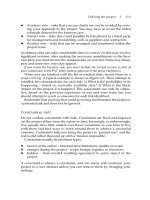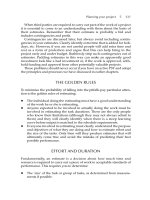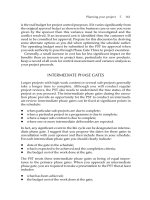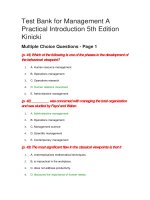Management a practical introduction 3rd kinicky chapter 06
Bạn đang xem bản rút gọn của tài liệu. Xem và tải ngay bản đầy đủ của tài liệu tại đây (296.76 KB, 38 trang )
Management
A Practical Introduction
Third Edition
Angelo Kinicki &
Brian K. Williams
Kinicki/Williams, Management: A Practical Introduction 3e ©2008, McGraw-Hill/Irwin
Chapter 6: Strategic Management
How Star Managers Realize
a Grand Design
The Dynamics of Strategic Planning
The Strategic Management Process
Establishing the Grand Strategy
Formulating Strategy
Execution
Kinicki/Williams, Management: A Practical Introduction 3e ©2008, McGraw-Hill/Irwin
Manager’s Toolbox
Lesson #1: in an era of management fads, strategic planning is
still tops
Lesson #2: a manager’s most valuable character trait: be
willing to make large, painful decisions to suddenly alter
strategy
McGraw-Hill/Irwin
Kinicki/Williams, Management: A Practical Introduction
3e ©2008,
McGraw-Hill/Irwin
© 2006
The McGraw-Hill
Companies, Inc. All rights rese
6.1 The Dynamics Of Strategic Planning
WHY IS IT IMPORTANT TO HAVE A STRATEGY?
Organizations need to know where they are going and how
they will get there
A large scale action plan that sets the direction for an
organization is a strategy - it is an educated guess about what
the organization has to do to survive
The process that involves managers from all parts of the
organization in the formulation and the implementation of
strategies and strategic goals is strategic management
Strategic planning determines the organization’s long term
goals and how the organization should achieve them
Kinicki/Williams, Management: A Practical Introduction 3e ©2008, McGraw-Hill/Irwin
Strategy, Strategic Management,
Strategic Planning
Strategy: is a large scale action plan that sets the
direction for the organization.
Strategic Management: is a process that involves
managers from all parts of the organization in the
formulation and the implementation of strategies and
strategic goals. (Middle managers)
Strategic Planning: determines not only the
organization’s long-term goals for the next 1-5 year
regarding growth and profits, but also the ways the
organization should achieve them
McGraw-Hill/Irwin
Kinicki/Williams, Management: A Practical Introduction
3e ©2008,
McGraw-Hill/Irwin
© 2006
The McGraw-Hill
Companies, Inc. All rights rese
6.1 The Dynamics Of Strategic Planning
There are three reasons to adopt strategic
management and strategic planning:
Kinicki/Williams, Management: A Practical Introduction 3e ©2008, McGraw-Hill/Irwin
Why Strategic Management and
Strategic Planning are Important
1)
2)
Providing direction & momentum
1)
Focuses on most critical problems, choices, & opportunities
2)
Creates teamwork, promotes learning, & builds commitment
Encouraging new ideas
1)
3)
Stresses importance of innovation
Developing a sustainable competitive advantage
1)
Ability to produce goods and services more effectively than
competitors
2)
Sustainable competitive advantage is staying ahead in:
McGraw-Hill/Irwin
1)
Being responsive to customers
2)
Innovating
3)
Quality
4)
Effectiveness
Kinicki/Williams, Management: A Practical Introduction
3e ©2008,
McGraw-Hill/Irwin
© 2006
The McGraw-Hill
Companies, Inc. All rights rese
6.1 The Dynamics Of Strategic Planning
WHAT IS AN EFFECTIVE STRATEGY?
Michael Porter argues strategic positioning
attempts to achieve sustainable competitive
advantage by preserving what is distinctive about a
company
Kinicki/Williams, Management: A Practical Introduction 3e ©2008, McGraw-Hill/Irwin
6.1 The Dynamics Of Strategic Planning
There are three key principles of strategic positioning:
1. An organization’s strategic position comes from serving few
needs to many customers like Jiffy Lube, serving broad needs
of a few customers like Bessemer Trust, or serving broad
needs of many customers
2. Companies have to choose what strategy to follow and also
what strategy not to follow – they have to make trade-offs
3. Creating a “fit” among activities is important - a company’s
activities should interact and reinforce one another
Kinicki/Williams, Management: A Practical Introduction 3e ©2008, McGraw-Hill/Irwin
Does Strategic Management
Work for Small as Well as Large?
1)
Also appropriate for companies with fewer than
100 employees
2)
Improvement in financial performance for these
companies was small and may not be worth the
effort
McGraw-Hill/Irwin
Kinicki/Williams, Management: A Practical Introduction
3e ©2008,
McGraw-Hill/Irwin
© 2006
The McGraw-Hill
Companies, Inc. All rights rese
The Five Steps of the Strategic
Management Process
WHAT IS THE STRATEGIC MANAGEMENT PROCESS?
The strategic management process has five steps plus a
feedback loop
1. Establish
the mission
and vision
2. Establish the
grand strategy
(using SWOT
and
forecasting)
3. Formulate
the strategic
plans (using
e.g. Porter)
4. Carry out
the strategic
plan
5. Maintain
strategic
control
Feedback: Revise actions, if necessary, based on feedback
McGraw-Hill/Irwin
Kinicki/Williams, Management: A Practical Introduction
3e ©2008,
McGraw-Hill/Irwin
© 2006
The McGraw-Hill
Companies, Inc. All rights rese
6.2 The Strategic-Management Process
Step 1: Establish The Mission & The Vision
A good mission statement expresses the
organization’s purpose or reason for being
A good vision statement describes the longterm goal of what the organization wants to
become
Kinicki/Williams, Management: A Practical Introduction 3e ©2008, McGraw-Hill/Irwin
Mission Statements
Does your company’s mission statement answer the following
questions?
Who are our customers?
What are our major products and services?
In what geographical areas do we compete?
What is our basic technology?
What is our commitment to economic objectives?
What are our basic beliefs, values, aspirations, and philosophical priorities?
What are our major strengths and competitive advantages?
What are our public responsibilities?
What is our attitude toward our employees?
McGraw-Hill/Irwin
Kinicki/Williams, Management: A Practical Introduction
3e ©2008,
McGraw-Hill/Irwin
© 2006
The McGraw-Hill
Companies, Inc. All rights rese
Vision Statements
Does your company’s vision statement answer “yes” to
the following questions?
McGraw-Hill/Irwin
Is it appropriate for the organization and for the times?
Does it set standards of excellence that reflect high ideals?
Does it clarify purpose and direction?
Does it inspire enthusiasm and encourage commitment?
Is it well articulated and easily understood?
Does it reflect the uniqueness of the organization, its distinctive
competence, what it stands for, what it’s able to achieve?
It is ambitious?
Kinicki/Williams, Management: A Practical Introduction
3e ©2008,
McGraw-Hill/Irwin
© 2006
The McGraw-Hill
Companies, Inc. All rights rese
6.2 The Strategic-Management Process
Step 2: Establish The Grand Strategy
The grand strategy explains how the organization’s
mission is to be accomplished
Three common grand strategies are growth
(involves expansion of sales revenue, market share,
number of employees, or number of customers
served), stability (involves little or no significant
change), and defensive (involves reduction in the
organization’s efforts)
Kinicki/Williams, Management: A Practical Introduction 3e ©2008, McGraw-Hill/Irwin
How Companies Can Implement
Grand Strategies
Growth Strategy
McGraw-Hill/Irwin
It can improve an existing product or service to attract more
buyers
It can increase its promotion and marketing efforts to try to
expand its market share
It can expand its operations, as in taking over distribution or
manufacturing previously handled by someone else
It can expand into new products or services
It can acquire similar or complementary businesses
It can merge with another company to form a larger company
Kinicki/Williams, Management: A Practical Introduction
3e ©2008,
McGraw-Hill/Irwin
© 2006
The McGraw-Hill
Companies, Inc. All rights rese
How Companies Can Implement
Grand Strategies (Cont.)
Stability Strategy
It can go for a no-change strategy
It can go for a little-change strategy
Defensive Strategy
It can reduce costs
It can sell off assets
It can gradually phase out product lines or services
It can divest part of its business
It can declare bankruptcy
It can attempt a turnaround
McGraw-Hill/Irwin
Kinicki/Williams, Management: A Practical Introduction
3e ©2008,
McGraw-Hill/Irwin
© 2006
The McGraw-Hill
Companies, Inc. All rights rese
6.2 The Strategic-Management Process
Step 3: Formulate Strategic Plans
The process of choosing among different strategies and
altering them to best fit the organization’s needs is strategy
formulation
The strategy formulation process can be completed using
techniques like Porter’s competitive forces and strategies, and
product life cycles
Step 4: Carry Out The Strategic Plan
Strategy implementation involves putting strategic plans into
effect
Managers need to ensure that the right people and control
systems are in place to execute the plans
Kinicki/Williams, Management: A Practical Introduction 3e ©2008, McGraw-Hill/Irwin
6.2 The Strategic-Management Process
Step 5: Maintain Strategic Control: The Feedback
Loop
Monitoring the execution of strategy and making
necessary adjustments is strategic control
To keep strategic plans on track, managers need to
encourage people, keep planning simple, stay
focused, and keep moving
Kinicki/Williams, Management: A Practical Introduction 3e ©2008, McGraw-Hill/Irwin
6.3 Establishing The Grand Strategy
HOW CAN A SWOT ANALYSIS HELP WITH
STRATEGY?
The starting point for a grand analysis is the SWOT
analysis (a search for the Strengths, Weaknesses,
Opportunities, and Threats affecting an organization)
A SWOT analysis provides managers with a
realistic understanding of where the organization is
relative to its internal and external environments
Kinicki/Williams, Management: A Practical Introduction 3e ©2008, McGraw-Hill/Irwin
6.3 Establishing The Grand Strategy
Organizational strengths include the skills and capabilities
that give the organization special competencies and
competitive advantages in executing strategies in pursuit of its
mission
Organizational weaknesses include the drawbacks that
hinder an organization in executing strategies in pursuit of its
mission
Organizational opportunities include environmental factors
that the organization may exploit for competitive advantage
Organizational threats include environmental factors that
hinder an organization’s achieving a competitive advantage
Kinicki/Williams, Management: A Practical Introduction 3e ©2008, McGraw-Hill/Irwin
6.3 Establishing The Grand Strategy
Figure 6.2: SWOT Analysis
Kinicki/Williams, Management: A Practical Introduction 3e ©2008, McGraw-Hill/Irwin
6.3 Establishing The Grand Strategy
After completing the SWOT analysis, managers
need to make forecasts (visions or projections of the
future)
There are two types of forecasts:
A hypothetical extension of a past series of events
into the future is a trend analysis
The creation of alternative hypothetical but equally
likely future conditions is contingency planning or
scenario planning
Kinicki/Williams, Management: A Practical Introduction 3e ©2008, McGraw-Hill/Irwin
6.4 Formulating Strategy
HOW IS STRATEGY FORMULATED?
Organizations can use many techniques to
formulate strategy including Porter’s five competitive
forces, Porter’s four competitive strategies, the
product life cycle, diversification and synergy, and
competitive intelligence
Kinicki/Williams, Management: A Practical Introduction 3e ©2008, McGraw-Hill/Irwin
6.4 Formulating Strategy
Porter’s Five Competitive Forces include:
1. The threat of new entrants
• New competitors can shake-up an industry virtually
overnight
2. The bargaining power of suppliers
• Companies that rely on a single supplier are vulnerable
Kinicki/Williams, Management: A Practical Introduction 3e ©2008, McGraw-Hill/Irwin









